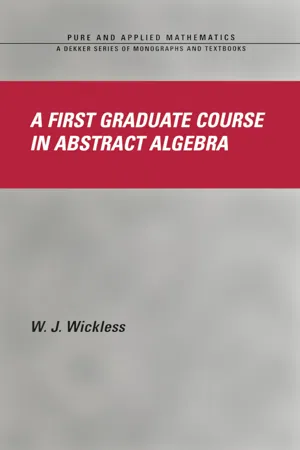
- 252 pages
- English
- ePUB (mobile friendly)
- Available on iOS & Android
A First Graduate Course in Abstract Algebra
About This Book
Since abstract algebra is so important to the study of advanced mathematics, it is critical that students have a firm grasp of its principles and underlying theories before moving on to further study. To accomplish this, they require a concise, accessible, user-friendly textbook that is both challenging and stimulating. A First Graduate Course in Abstract Algebra is just such a textbook.Divided into two sections, this book covers both the standard topics (groups, modules, rings, and vector spaces) associated with abstract algebra and more advanced topics such as Galois fields, noncommutative rings, group extensions, and Abelian groups. The author includes review material where needed instead of in a single chapter, giving convenient access with minimal page turning. He also provides ample examples, exercises, and problem sets to reinforce the material. This book illustrates the theory of finitely generated modules over principal ideal domains, discusses tensor products, and demonstrates the development of determinants. It also covers Sylow theory and Jordan canonical form.A First Graduate Course in Abstract Algebra is ideal for a two-semester course, providing enough examples, problems, and exercises for a deep understanding. Each of the final three chapters is logically independent and can be covered in any order, perfect for a customized syllabus.
Frequently asked questions
Information
Chapter 1
Groups (mostly finite)
1.1 Definitions, examples, elementary properties
- G is a set and o is a binary operation on G.
- There is an element e ∈ G such that eºx = xºe = x for all x ∈ G.
- For all x,y,z ∈ G, x º (y º z) = (x º y) º z. (The operation º is associative.)
- For all x ∈ G, there exists an element y ∈ G such that xºy = yºx = e.
Table of contents
- Cover Page
- Half Title Page
- Title Page
- Copyright Page
- Preface
- Contents
- Chapter 1 Groups (mostly finite)
- Chapter 2 Rings (mostly domains)
- Chapter 3 Modules
- Chapter 4 Vector Spaces
- Chapter 5 Fields and Galois theory
- Chapter 6 Topics in noncommutative rings
- Chapter 7 Group extensions
- Chapter 8 Topics in abelian groups
- References
- Index